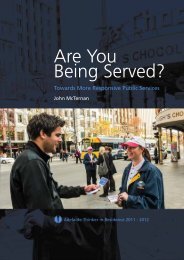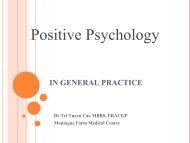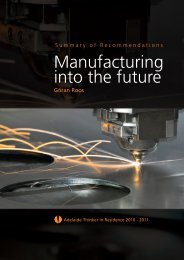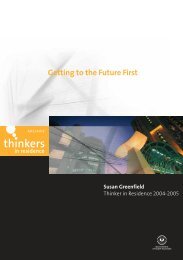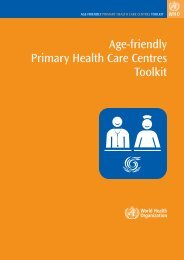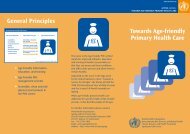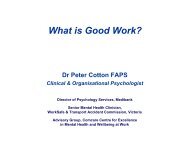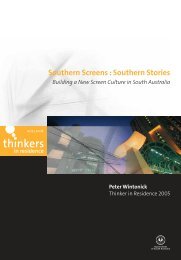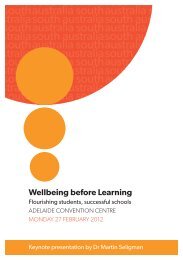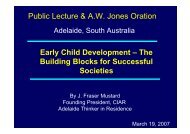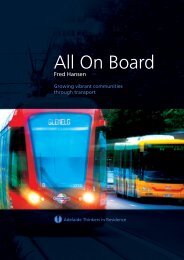Download pdf of Fred Hansen's report - Adelaide Thinkers in ...
Download pdf of Fred Hansen's report - Adelaide Thinkers in ...
Download pdf of Fred Hansen's report - Adelaide Thinkers in ...
- No tags were found...
You also want an ePaper? Increase the reach of your titles
YUMPU automatically turns print PDFs into web optimized ePapers that Google loves.
‘It is never too earlyto <strong>in</strong>volve citizens<strong>in</strong> issues directlyaffect<strong>in</strong>g theirneighbourhoods ...’6. Community<strong>in</strong>volvementIn the greater <strong>Adelaide</strong> area a basic conflict exists around how tomake community <strong>in</strong>volvement work while not allow<strong>in</strong>g a few toderail projects for selfish reasons. Time and time aga<strong>in</strong> I hear fromcommunity members that they have not been <strong>in</strong>volved <strong>in</strong> key projectsor programs until well along <strong>in</strong> the development process. And likewiseI hear from government, both local and state, that it is premature tobeg<strong>in</strong> discussions with the public when a project or program has notreceived the bless<strong>in</strong>g to proceed from elected leadership and noth<strong>in</strong>gmay come <strong>of</strong> it.As I have watched similar debates around the world, around theUnited States and certa<strong>in</strong>ly <strong>in</strong> my own community <strong>of</strong> Portland,Oregon, I believe there are ways to move forward, meet<strong>in</strong>g thegoals <strong>of</strong> all stakeholders. First and foremost, systems agreed to bystakeholders must be put <strong>in</strong> place that f<strong>in</strong>d common ground, notbattle ground. And the most successful <strong>of</strong> these efforts have been,<strong>in</strong> my view, when there is a structure for people to become engagedthrough work<strong>in</strong>g with other people <strong>in</strong> their own communities.C O M M U N I T Y I N V O L V E M E N TThe City <strong>of</strong> Portland provides one model <strong>of</strong> how to achieve effectivecommunity <strong>in</strong>volvement, although there are many other models fromaround the world that <strong>Adelaide</strong> should evaluate to determ<strong>in</strong>e howbest to structure a system that works.Form<strong>in</strong>g neighbourhood associationsThe Portland model is based on government assist<strong>in</strong>g the creation<strong>of</strong> local neighbourhood associations. These associations are formedthrough democratically elected neighbourhood <strong>of</strong>ficers. Their sizeis small enough to allow active and engaged community membersto participate mean<strong>in</strong>gfully. In Portland, on average, there is aneighbourhood association for each approximately 5000 residents.The boundaries <strong>of</strong> the association are def<strong>in</strong>ed by naturally occurr<strong>in</strong>gdemarcations, such as topography, waterways, major roads, schooldistricts or other items that mean there is a natural coherence andlikeness <strong>of</strong> outlook for each neighbourhood.There is also a requirement that government must engagethe neighbourhood associations <strong>in</strong> decisions affect<strong>in</strong>g thatneighbourhood, whether it be a liquor licence application or aproposed major new development. The neighbourhood associationshave stand<strong>in</strong>g to formally participate <strong>in</strong> the various reviews conductedby government approval bodies.42 FRED HANSEN: ALL ON BOARDFRED HANSEN: ALL ON BOARD 43




